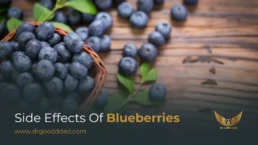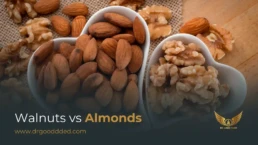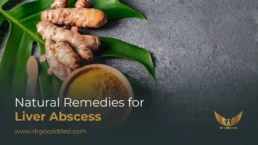What are postbiotics?
Postbiotics are tiny substances left behind when good bacteria break down food. These tiny helpers can come in many forms. They include things like short-chain fatty acids, enzymes, and bits of friendly bacteria.
Table of Contents
ToggleThe postbiotics are the byproducts of healthy gut bacteria that help your body. These helpers stay in your gut and support your body. They differ from foods like fermented foods, which contain live bacteria.
Postbiotics are not alive. They are what live bacteria leave behind. That link between prebiotics, probiotics and postbiotics helps your tummy feel good.
Health benefits of postbiotics
May help boost your immune system
One of the strongest postbiotics benefits is supporting your immune response. Postbiotics can signal immune cells to react quickly against harmful microbes while preventing unnecessary inflammation. This balance helps your body fight infections while avoiding excessive immune reactions.
May help reduce digestive symptoms
Postbiotics help improve digestive health by reducing bloating, gas, and discomfort. They feed healthy gut bacteria and encourage the production of short-chain fatty acids (SCFAs), which soothe inflammation and support a stronger, healthier intestinal barrier.
May help prevent and treat diarrhea
Certain postbiotics supplements can speed recovery from diarrhea caused by infections or antibiotics. They help restore microbiota balance, slow excessive bowel movements, and promote better water absorption, reducing the risk of dehydration.
Other potential benefits
Beyond gut support, postbiotics may improve colon health, help regulate the gut-brain axis, and promote microbiome diversity. Their anti-inflammatory properties may also protect against chronic conditions linked to inflammation, while boosting nutrient absorption and the activity of digestive enzymes.
Potential downsides and safety
Postbiotics seem safe for most people. They come from good bacteria. You usually get them from safe foods. But if you have health issues or allergies, ask a doctor first. An overabundance of anything may result in stomach disturbances. So take them slowly to see how your body reacts.
How to add postbiotics to your diet
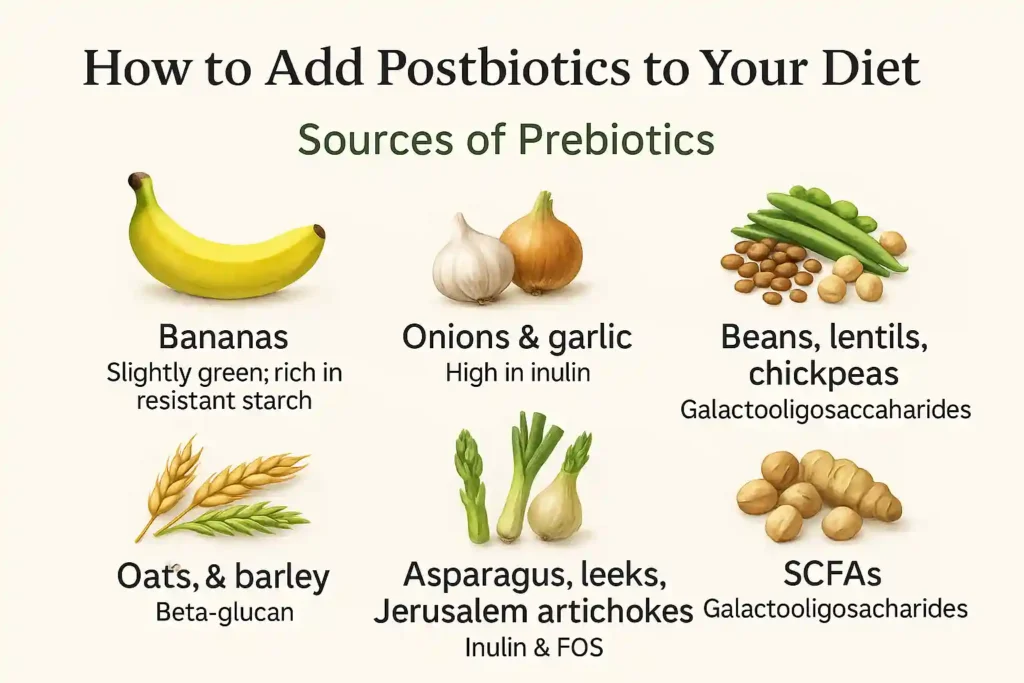
To get more postbiotics, start with the foods that feed good bacteria.
Sources of prebiotics
Prebiotics are non-digestible fibers and plant compounds that feed healthy gut bacteria, helping them grow and produce beneficial postbiotics. When you regularly eat prebiotic-rich foods, you create the perfect environment for your gut microbes to thrive.
Common food sources include:
- Bananas: especially when slightly green, as they’re higher in resistant starch, which acts as a powerful prebiotic.
- Onions and garlic: rich in inulin, a fiber that supports the growth of beneficial bacteria linked to better colon health.
- Oats and barley:contain beta-glucan, which helps improve digestive health while boosting postbiotic production.
- Legumes: beans, lentils, and chickpeas are packed with galactooligosaccharides (GOS), which promote microbiota balance.
- Asparagus, leeks, and Jerusalem artichokes: excellent sources of inulin and fructooligosaccharides (FOS), which encourage more short-chain fatty acids (SCFAs) in your gut.
Eating a variety of these foods daily ensures different bacterial strains in your gut get the fuel they prefer, leading to improved microbiome diversity and more potent postbiotics benefits.
Sources of probiotics
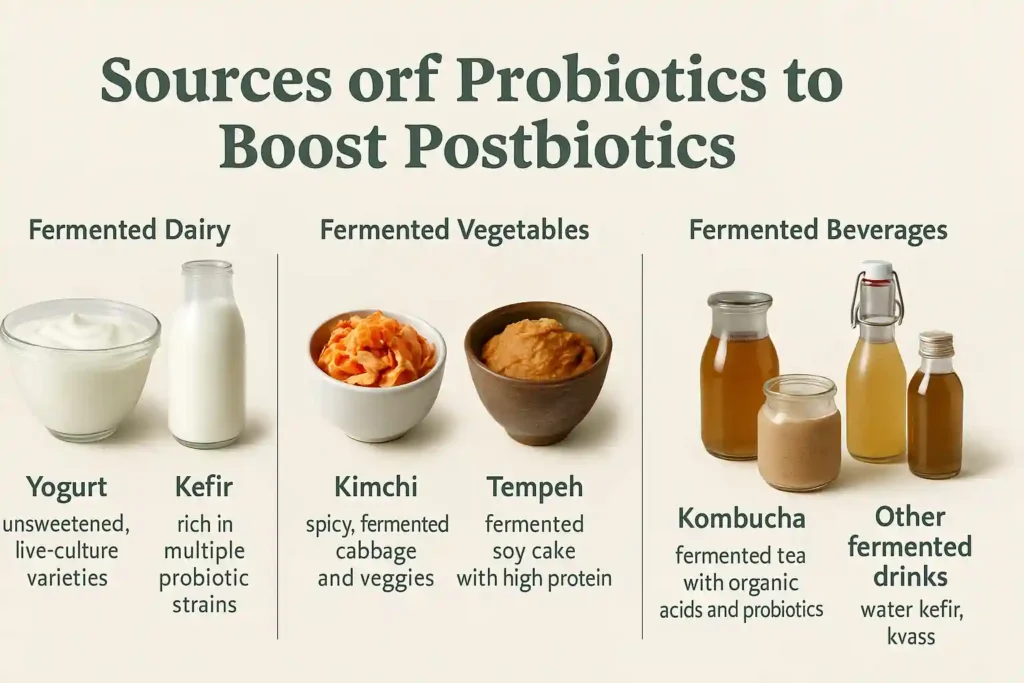
To get postbiotics naturally, you first need probiotics, the live bacteria that produce them. Pairing probiotics with prebiotics (known as prebiotics probiotics and postbiotics synergy) boosts both bacterial growth and postbiotic production.
The best sources of probiotics are fermented foods, which have been preserved and enhanced by live cultures:
- Yogurt: choose unsweetened, live-culture varieties for the highest levels of lactic acid bacteria.
- Kefir: a fermented milk drink containing multiple probiotic strains that produce a wide range of beneficial postbiotics.
- Kimchi and sauerkraut: fermented vegetables that bring beneficial bacteria and vitamins, plus compounds with anti-inflammatory properties.
- Miso and tempeh: soy-based fermented foods that not only add probiotics but also protein and minerals.
- Kombucha: a fermented tea containing probiotics, organic acids, and antioxidants.
Regularly eating probiotic-rich foods ensures a steady supply of bacterial strains that produce postbiotics supplements naturally in your gut, supporting digestive enzymes activity, nutrient absorption, and immune health.
The Bottom Line
Postbiotics are simple, safe, and smart helpers in your gut. They come from friendly bacteria after they eat food. They aid your body in fighting infections, calming your digestive tract, and even improving your mood through the gut-brain relationship.
You get them when you eat foods that feed or are filled with good bacteria. You don’t need to complicate things. A happy gut helps you feel good every day.
FAQs
What are examples of postbiotics?
They include short-chain fatty acids (SCFAs), peptides, polysaccharides, and cell wall fragments from bacteria. These compounds improve gut function, reduce inflammation, and strengthen the intestinal barrier against harmful microbes.
What are the benefits of postbiotics?
Postbiotics benefits include improved digestive health, stronger immunity, better colon health, and enhanced nutrient absorption. They also help maintain microbiome diversity and support mental well-being through the gut-brain axis.
Are postbiotics better than probiotics?
They’re different, not better. Probiotics are living bacteria, while postbiotics refer to their beneficial byproducts. Both are essential, especially when combined in a synergistic manner with probiotics and prebiotics for ideal gut performance.
What is the difference between a prebiotic and a probiotic?
Prebiotics feed good bacteria. Probiotics are the live bacteria themselves. Together, they promote microbiota balance and allow your gut to produce valuable postbiotics for better health.
Is yogurt a prebiotic or probiotic?
Yogurt is a probiotic food because it contains live bacteria like lactic acid bacteria. Eating it regularly can increase the production of postbiotics in your gut.
Can I take probiotics and postbiotics together?
Yes. Combining them with prebiotics ensures better microbiome diversity, stronger immunity, and improved digestion. This three-way combination fuels long-term gut and overall health.
How long does it take for postbiotics to work?
Some benefits may appear in a few days, like reduced bloating or diarrhea. Full effects, including better microbiota balance and immunity, may take several weeks of consistent intake.

This article is medically reviewed by Dr. Nivedita Pandey, Senior Gastroenterologist and Hepatologist, ensuring accurate and reliable health information.
Dr. Nivedita Pandey is a U.S.-trained gastroenterologist specializing in pre and post-liver transplant care, as well as managing chronic gastrointestinal disorders. Known for her compassionate and patient-centered approach, Dr. Pandey is dedicated to delivering the highest quality of care to each patient.


